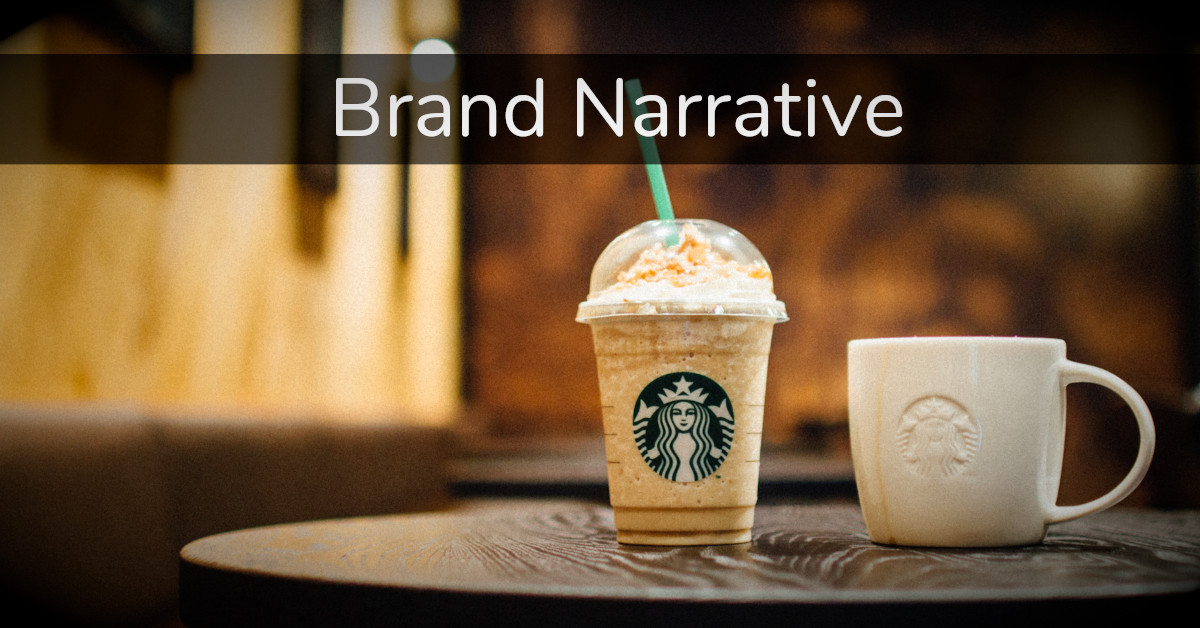This module is part of a free online course where you can learn digital marketing.
- Brand Narrative & The Art Of Storytelling [Video]
- How Narratives Affect Business & Markets
- The Why That Drives Your Company
- Building A Brand With A Strong Narrative
- 3 Brand Narrative Examples
- Expressing Narratives With Brand Storytelling
- How To Share Your Brand Narrative
Brand Narrative & The Art Of Storytelling [Video]

How Narratives Affect Business & Markets
What Does Brand Narrative Mean?
A brand narrative is the story behind a brand. It may be in the form of a founders journey to success, a noble quest to create a better world or simply a reason to be for the enterprise.
Narratives affect our everyday purchasing decisions on a sub-conscious level. We all know stories behind businesses that influence how we interact with the products of those companies.
Use the FANG stocks as an example (Facebook, Amazon, Netflix & Google). You likely know how some of these companies got started.
- Mark Zuckerbergs dorm room social media network (now a Hollywood movie)
- Jeff Bezos’s battle through the dot com bubble
- Netflix pivoting from a rent-a-DVD model
- Larry & Sergey’s garage experiment that became Google and their mission to organize the worlds information.
Whenever we interact with a company the story that we recall, through sub-conscious cognitive hooks, will influence our decision making process.
This is how big brands sell goods at a markup over the exact same products with supermarket generic packaging.
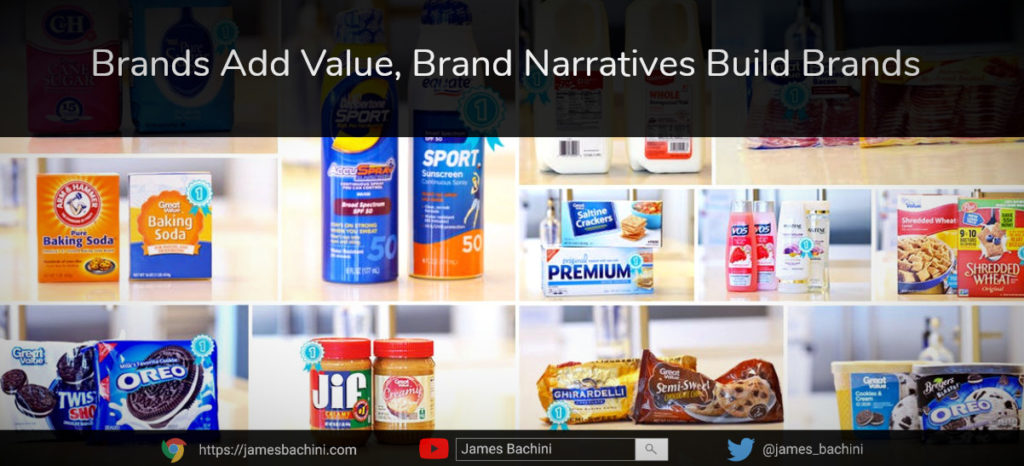
It’s not just purchasing decisions that are influenced by brand narratives though. In Robert J. Shiller’s book Narrative Economics he makes a case for narratives influencing financial markets.
“We need to incorporate the contagion of narratives into economic theory. Otherwise, we remain blind to a very real, very palpable, very important mechanism for economic change, as well as a crucial element for economic forecasting. If we do not understand the epidemics of popular narratives, we do not fully understand changes in the economy and in economic behavior.”
In the blockchain and fintech sector I frequently see projects with strong narratives outperforming in the short term. Retail investors see a good brand narrative as something that simply makes sense, smoothing the path to speculative investment.
The Why That Drives Your Company
Many startups are born out of “we can create something, perhaps we can sell it”, they exist because it was possible for them to exist. However this doesn’t provide a compelling narrative. Founders need to think about why their business is going to be important. How will this product or enterprise influence the world?
Having a mission or story that forms the why is critical in many aspects of business. In 1983 Steve Jobs famously asked Pepsi CEO John Sculley
“Do you want to sell sugar water for the rest of your life, or do you want to come with me and change the world?”
Sculley later said that the question hit him like a punch in the gut and he started working at Apple in April 1983.
Jobs believed what he was doing was going to change the world and that made attracting the best talent possible.
A modern example would be how Elon Musk can hire and overwork the best in any industry because the causes that he creates businesses around are worthy of a lifetimes dedication and hard work.
Start With The Why
There’s an excellent Ted Talk by Simon Sinek on what he calls the Golden Circle which enables leaders to inspire.
In this talk he explains how most businesses know what they do. Good businesses know how they do it and what differentiates them from the competition. The best businesses know why they are arriving at work each morning. They have a compelling narrative for their own existence.
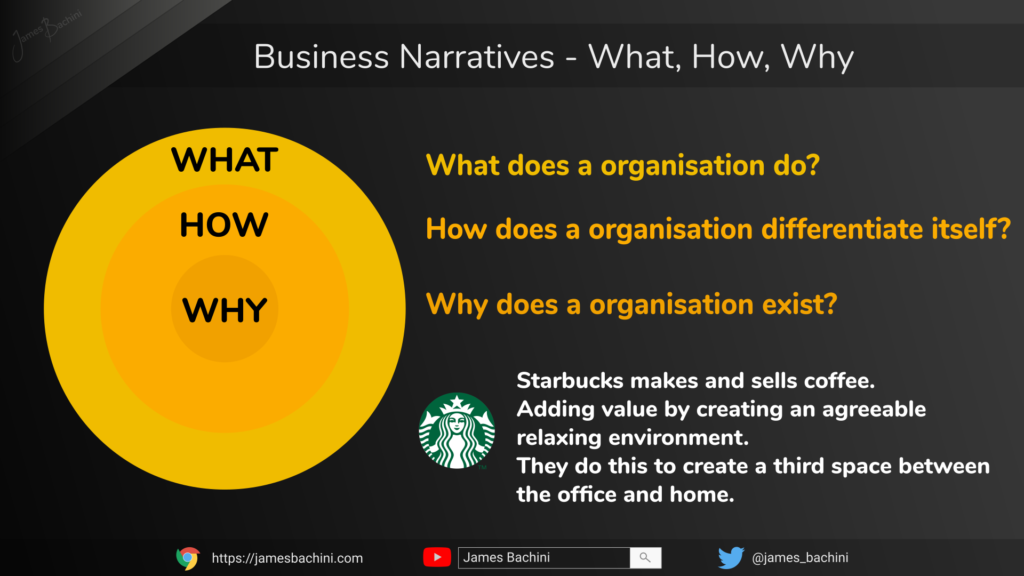
Startups and founders have the advantage that they can start with the why. Businesses can be built around a core belief or aspiration. Existing businesses may need to revisit the fundamentals and look at what makes them great to rediscover their why.
Building A Brand With A Strong Narrative
Brands are built around the image we have of them. In many cases a brand image can add enough value to a product to provide the margins required for business success.
Nespresso makes coffee machines in factories and packages coffee in an aluminum processing plants. However when we think Nespresso we think about a suave George Clooney chatting to a girl in a black cocktail dress.
This image connects with our psychological ideal-self which in turn compels us to buy one coffee machine over another.
When a consumer thinks of your brand what are the first 3 words you want to come to mind? This is the brand image.
Narratives are used to tell a brands story and cement the brands image in the minds of the people who interact with a business.
Stories get told and spread naturally. Elon Musk didn’t have to directly tell you about his Mars mission because you’ve already heard about it numerous times from 3rd parties.
It has been proven that stories increase the levels of Oxytocin (the love hormone) which is one of the reasons why they have been so pivotal to human development. Religions, empires and enterprises have all been built on influence created through storytelling.
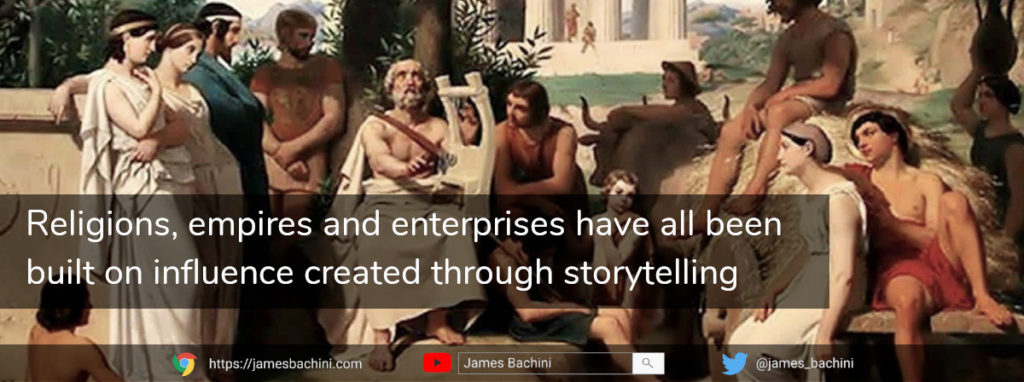
This is how great brands are built too. A compelling story is crafted and seeded from which it can grow to form the foundation of how we conceptualize a business or product.
The stories that a company tells about itself creates the brand image. If a business does not create and control the brands narratives then others will create it for them.
3 Brand Narrative Examples
Revolut Brand Narrative
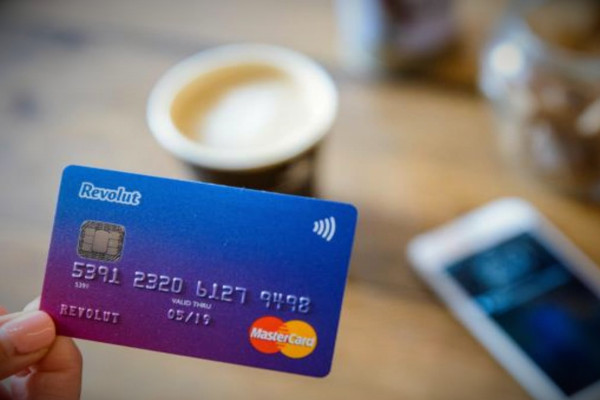
Revolut is a UK fintech company that provides prepaid mastercards alongside a consumer banking app.
I first heard about Revolut in a bar from an early investor and evangelist. The pitch was simple “it stops you getting ripped off when taking money out abroad”.
I travel a lot, this was something that directly appealed and touched on a pain point that I had experienced first hand. Using a UK card abroad means getting criminal exchange rates alongside a flat fee of between $5-10 per use.
Revolut fixed this by offering interbank fair exchange rates and no fees. They also built a market leading app and simplified the process of remote account sign up.
The result. I haven’t stepped foot in a high street bank for years. Many millennials never will. Why would they stand in queue when they can open up a Revolut account in 19 clicks? Traditional banks are quickly becoming things that get robbed on Netflix as consumer behavior migrates online.
This is the narrative that is powering a revolution in the UK financial sector.
SpaceX Brand Narrative

Elon Musk is a man on a mission. He wants to make humans a interplanetary species. There are ambitious projects and then there’s trying to setup a colony on Mars.
But the idea that having a secondary planet would create a safe-haven for the human race is compelling. It would enable life to continue in the event of a global disaster, nuclear war or asteroid impact.
This ambition and narrative fuels SpaceX and to an extent Elon’s other companies Tesla and Solar City. SpaceX has reignited the space race on a commercial level and narrative is powering that.
GoPro Brand Narrative

Nick Woodman went from selling shell jewellery out of the back of a VW camper van to founding one of the biggest consumer electronics startups GoPro.
It started with the idea that he wanted to film himself surfing. Combining a small camera with a water proof case and a wide angle lens became a billion dollar industry.
GoPro were the first to release an action cam and the narrative grew with the brand. To this day they are able to sell cameras at a higher price point despite the influx of cheaper alternatives flooding the market.
Expressing Narratives With Brand Storytelling
Narratives are best formed through storytelling. Let’s look at how to create a brand story.
Storytelling Basics

All stories should have a beginning, middle and an end. The beginning should set the normal and introduce characters. The middle should have a form of conflict. The ending resolves the conflict and describes the new normal.
Certain types of stories work really well for brand narratives such as:
- Founders Story – how the brand came to be
- Raison d’etre – the brand’s reason to be
- Lost & Found – overcoming adversity
- Hero’s Journey – Failures to successes
- Secret Discovery – Presenting original research
- David & Goliath – Big wins for the little brands
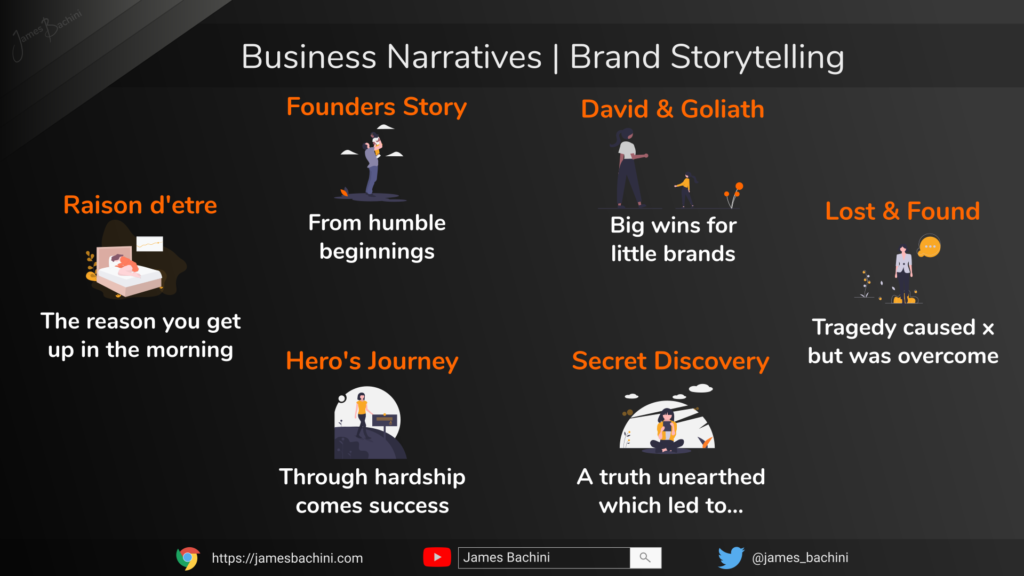
Characters need to be relatable to the audience. The story should always be focused on the reader or listener. A flawed but wonderful founder that overcame failures to eventually feed his family is much more interesting than a straight A superhero that never put a foot wrong.
Authenticity is key to the story cementing a brand image in the consumers mind. It’s almost impossible to fake and something that’s created just for marketing purposes will sound like what it is. Oil companies can do as much environmental PR as they want with little effect on public opinion.
Balance emotional and intellectual triggers. Good stories trigger an emotional response. Think of the best films you’ve watched. This needs to be balanced with making the story intellectual enough to be realistic and believable.
Don’t be afraid to get personal with the narrative. People like interacting with people, not brands. If you can put a name and a face behind the brand then that can build trust and long term benefits.
Go ahead and tell your story in a way that expresses the core values of what your brand is all about. Focus on the why to create a brand image that cements your company in the minds of consumers.
How To Share Your Brand Narrative
Once you have a compelling brand narrative it needs to be seeded or it will become another story untold.
Here are some methods for sharing a brands narrative.
Social Media
From the images to videos to articles. The content that a brand produces will create part of that brands image. This makes it an ideal distribution channel for a brand narrative.
Short form video works really well here. It can simply be a talking head interview style or you can take it as far as a full blown professional video production. The story is most important and fancy transitions wont make up for a weak narrative.
Social media posts can be promoted using the associated ad networks to distribute the story wide and far. There are modules on Google Ads and Facebook Ads which detail how campaigns can be effectively run.
Instagram is a good choice for B2C brands whereas Linkedin works well for B2B. Check the demographic of the network matches your ideal customer.
Content Marketing
Most brands should have some form of contact marketing already in place. This is an ideal channel to start telling your story in a way that will interest readers.
Content should always educate, entertain and inspire. A good narrative should be able to entertain through storytelling, educate the reader on your mission and why it should matter to them and inspire them to join you on the journey.
Every email that you send is an opportunity to develop the brand image in the minds of the customers and leads.
It’s unlikely anyone want’s to receive a “How We Got Started” email for the tech gadget they just want delivered. But creative writing and copywriting can be combined with transactional emails and newsletters to slowly engage the consumer and deliver the brand narrative.
With emails keep it short, personal and try to deliver value for the reader.
Taglines
A companies tag line is normally the second most repeated phrase after the brand name.
This provides an opportunity to do a condensed elevator pitch on the companies reason to be.
Here are some good examples:-
- BMW “Designed for driving pleasure”
- Casper “The best bed for better sleep”
- Levis “Quality never goes out of style”
Admittedly it’s hard to condense an entire narrative into 10 or less words. The examples above do a good job of expressing and delivering a brand image in the shortest way possible.
Packaging & Print
If you are delivering physical or even digital goods then there is a perfect time to tell the brands story. Consider including a letter or leaflet which tells the brand narrative.
Make sure any content is skimable as less than 100% of customers will read it word for word.
Anything that your company has printed is also an opportunity to tell your brands story through images, colours, text. Company attire, event displays and office interiors are all opportunities to reinforce brand image.
Conclusion
Brand narratives and brand storytelling have formed an important part of the marketing mix for as long as marketing has existed. In modern times there is a resurgence of marketers and founders working hard to establish narratives to create a positive brand image.
A brands narrative can influence the perceived value of their products, consumers purchasing behavior, investment decisions and even internal operations such as hiring talented personnel.
Founders can create narratives by focusing on the why, the rasion d’etre for their enterprise. The more compelling this is the easier it will be to put it into a story that connects with consumers.
This article is part of a free online course where you can learn digital marketing.
If you’ve enjoyed these resources could you help share this content on social media and send it to anyone who you think might benefit from it.
Thank you.


